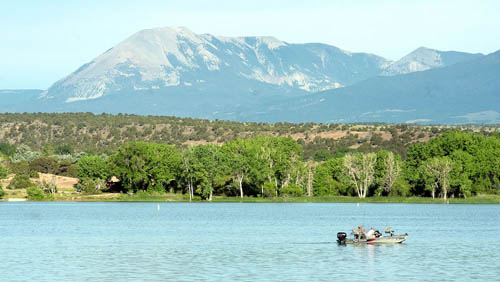This week, we’re exploring Colorado’s very first state park: Lathrop! Lathrop State Park is located just west of Walsenburg, at an elevation of 6200 feet. It features 1,460 acres of high plains grassland with pinon and juniper trees, views of the Spanish Peaks, two reservoirs, and a golf course. The park officially opened in 1962 and is named after Howard W. Lathrop, Colorado’s first parks and recreation director.

People had been enjoying the area surrounding Lathrop for thousands of years before it became a state park. Evidence of ancient people living in rocky outcroppings and underneath crags has been found throughout the area. The nearby Spanish Peaks were often used as navigational guides by those traveling through the area in the pre-Google Maps era. In the 1800s, Thomas Martin developed the reservoir (now Lake Martin) and opened a tourist resort with a hotel, cabins, and fruit orchards. The area was first opened to the public in 1946 under the name Huajatolla Park.
Wildlife enjoy the park as much as we do. Mule deer, rabbits, coyotes, and bobcats roam throughout the park, along with many species of fish and birds. The park is renowned for its exceptional birding opportunities, especially around Horseshoe Lake, which is reserved for wildlife-based use. See how many you can spot using the Birds at Lathrop State Park checklist!
While Horseshoe Lake is for quieter activities like canoeing, fishing, and birding, Martin Lake is open to recreational activities like jetskiing, waterskiing, and tubing. As always, make sure to follow guidelines to avoid introducing invasive species to Colorado’s waterways and get an ANS stamp before launching any watercraft. As a warm water reservoir, Martin Lake is also perfect for swimming.
Are you interested in visiting Colorado’s oldest state park? Read more about Lathrop in our digital repository and plan a trip!
- Growing container gardens in Colorado - March 21, 2025
- Colorado’s Scenic and Historic Byways: Grand Mesa - March 7, 2025
- Understanding Colorado’s electric vehicle tax credit - February 24, 2025